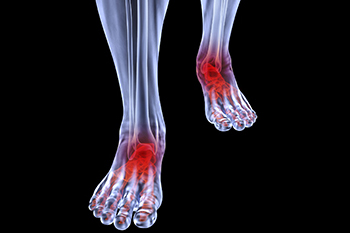Arthritic Foot Care

Conditions affecting the feet due to complications with arthritis can take many forms, including osteoarthritis, rheumatoid arthritis, gout, psoriatic arthritis, and ankylosing spondylitis. Osteoarthritis typically affects the joint connecting your big toe to your foot, though it can also be found in the midfoot or ankle region. Unlike osteoarthritis, rheumatoid arthritis typically affects both feet and deals with the same joints on each foot. Gout, which normally affects the big toe, is comprised of needle-like crystals that trigger inflammation in the joints. Psoriatic arthritis causes sausage-like swelling in the toes. Lastly, ankylosing spondylitis can lead to plantar fasciitis and pain at the Achilles tendon.
Many factors play a role in the cause for arthritic feet, including obesity, the aging process, as well as family history or genetic connections to arthritis.To help prevent issues with your feet, examine your feet daily, keep your feet clean, routinely moisturize your feet, keep your toenails trimmed, inspect your shoes for anything that may cause discomfort, and wear socks on a daily basis.
If you’re experiencing any discomfort or pain due to one of the above forms of arthritis, consider over-the-counter pain medication and investing in comfortable footwear. Pain medication coupled with top of the line comfort footwear is a great way to ease the pain that often comes with arthritis. If you’re overweight, it’s also recommended to think about setting a weight loss goal to ease some of the pressure on your feet, as well stay as active as possible. Applying ice or heat to the affected area is another way to calm the discomfort you may experience. It’s important to do research and see whether inserts may be beneficial for you. General foot care, like pampering your feet and keeping them well maintained, is also recommended. Lastly, you should seek professional advice and learn about potential surgery options, if necessary.
For an official diagnosis and information on treatment options, consult with a podiatrist.
